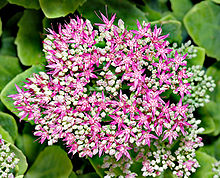Hylotelephium
| Hylotelephium | |
|---|---|

| |
| Hylotelephium spectabile | |
| Scientific classification | |
| Kingdom: | Plantae |
| Clade: | Tracheophytes |
| Clade: | Angiosperms |
| Clade: | Eudicots |
| Order: | Saxifragales |
| Family: | Crassulaceae |
| Subfamily: | Sempervivoideae |
| Genus: | Hylotelephium H.Ohba |
| Type species | |
| Hylotelephium telephium (L.) H.Ohba
| |
| Species | |
|
See text | |
Hylotelephium is a genus of flowering plants in the stonecrop family Crassulaceae. It includes about 33 species distributed in Asia, Europe, and North America.
Species in the genus, formerly included in Sedum, are popular garden plants, known as "sedum", "stonecrop", "live-for-ever" or "orpine". Horticulturalists have hybridized many of the species to create new cultivars. Many of the newer ones are patented, so may not be propagated without a license.
Taxonomy
Hylotelephium telephium and related species have been considered in a number of different ways since first being described by Linnaeus in 1753, including as a section of Sedum by Gray in 1821,[1] or a subgenus. But these taxa are quite distinct from Sedum morphologically.[2]
Hylotelephium is one of a group of genera that form a separate lineage from Sedum, and is closely related to Orostachys, Meterostachys, and Sinocrassula.[3][4]
The separation of the genus has not been universally adopted, for instance a Missouri Botanical Garden website states "Upright Sedums were at one point separated into the genus Hylotelephium, but are now generally included back in the genus Sedum."[5] One of Kew Garden's online databases also lists Hylotelephium as a synonym for Sedum.[6]
Species
Species include:[7]
- Hylotelephium cauticola
- Hylotelephium erythrostictum
- Hylotelephium pallescens
- Hylotelephium spectabile
- Hylotelephium telephioides
- Hylotelephium telephium
- Hylotelephium verticillatum
Hybrids
Etymology
Hylotelephium means ‘woodland distant lover’. ‘Hylo’ is derived from Greek, meaning ‘forest’ or ‘woodland’. ‘Telephium’, also derived from Greek, means ‘distant-lover’; the plant was thought to be able to indicate when one's affections were returned.[8]
References
Bibliography
- Gledhill, David (2006). The names of plants (4th ed.). Cambridge: Cambridge University Press. ISBN 0521866456.
{{cite book}}: Invalid|ref=harv(help) - Gray, Samuel Frederick (1821). "Sedum Telephium". A natural arrangement of British plants: according to their relations to each other as pointed out by Jussieu, De Candolle, Brown, &c. 2 vols. London: Baldwin, Cradock, and Joy. pp. ii: 539–540.
{{cite book}}: Invalid|ref=harv(help) - Thiede, J; Eggli, U (2007). "Crassulaceae". In Kubitzki, Klaus (ed.). Berberidopsidales, Buxales, Crossosomatales, Fabales p.p., Geraniales, Gunnerales, Myrtales p.p., Proteales, Saxifragales, Vitales, Zygophyllales, Clusiaceae Alliance, Passifloraceae Alliance, Dilleniaceae, Huaceae, Picramniaceae, Sabiaceae. pp. 83–119. ISBN 978-3540322146.
{{cite book}}: Invalid|ref=harv(help) (full text at Research Gate) - Mayuzumi, Shinzo; Ohba, Hideaki (2004). "The Phylogenetic Position of Eastern Asian Sedoideae (Crassulaceae) Inferred from Chloroplast and Nuclear DNA Sequences". Systematic Botany. 29 (3): 587–598. doi:10.1600/0363644041744329. ISSN 0363-6445. JSTOR 25063994.
{{cite journal}}: Invalid|ref=harv(help) - Ohba, Hideaki (March 1977). "The taxonomic status of Sedum telephium and its allied species (Crassulaceae)". The Botanical Magazine Tokyo. 90 (1): 41–56. doi:10.1007/BF02489468.
{{cite journal}}: Invalid|ref=harv(help) - Fu, Kunjun; Ohba, Hideaki; Gilbert, Michael G. (2004). "Hylotelephium H. Ohba". p. 209. Retrieved 24 August 2019., in Flora of China online vol. 8
- "Sedum 'Purple Emperor'". Plant Finder: Gardening Help. Missouri Botanical Garden. Retrieved 17 October 2019.
- POWO (2019). "Hylotelephium H.Ohba". Kew Science. Royal Botanic Gardens, Kew. Retrieved 1 September 2019.
{{cite web}}: Invalid|ref=harv(help) - TPL (2013). "The Plant List Version 1.1: Hylotelephium". Royal Botanic Gardens, Kew and Missouri Botanical Garden. Retrieved 1 September 2019.
{{cite web}}: Invalid|ref=harv(help)
